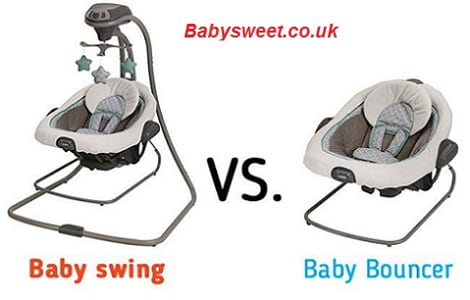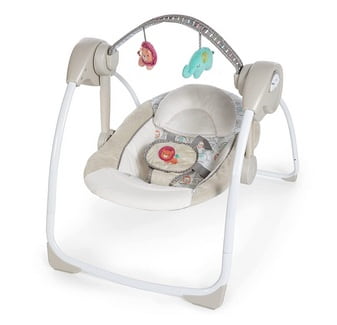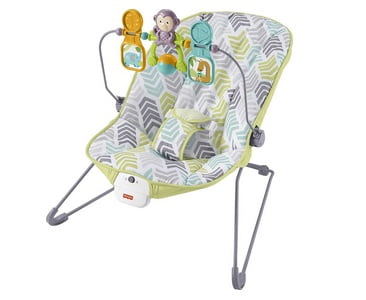
Both baby swings and baby bouncers are great for comforting your fussy baby or keeping them busy while you get your stuff done. Despite the baby swing vs bouncer differences, they both have long been a popular option among new parents.
Let’s take a look at the comparison of baby swings and bouncers down below for more information!
What Is A Baby Swing?
A baby swing, as the name implies, is a softly cushioned chair with a solid frame. At first glance, it looks similar to a grown-up swing.
A baby swing works in a side-to-side or back and forwards motion. It offers the same comfort, just like when your little one is in the womb. That’s why the devices can be used from birth until the kid is about 6-9 months of age.

A baby swing can be used from birth until the kid is about 6-9 months old
Baby swings provide much-needed relief for parents’ arms when they are unable to hold their child. They also give the soothing effect that newborns crave and support healthy spine growth.
Some swings require electricity, while others run on batteries, and yet others can be used with either. There are also several setting options allowing you to control the motion’s intensity and speed.
What Is A Baby Bouncer?
Bouncer, just like the previous product, is intended for newborn babies who are unable to sit unsupported and can last up to 9 months of age.
Bouncer keeps your child in recline positions or bounces them in different directions with soothing motions. Compared to swings, bouncers have a less complicated design. They usually have a padded chair with a compact frame that can spring up and down or sideways.
In the early weeks and months, parents or caregivers are in charge of the movement. They will need to rock the bouncer with your hand gently.

Bouncers will provide gentle movements.
But after a few months, when your child can wiggle their legs and flap their arms, it’s where the bundle of joy begins. Now the child can power the natural rocking motion by themselves. When the child moves, it bounces, but it will also stop when the child stops.
Baby Swing Vs Bouncer Comparison
When we compare the many features of a baby swing vs bouncer, we can clearly see that there’s not much of a difference in terms of usage.
First off, since swings need battery power or a power outlet, they are often not transportable and are heavier than bouncers. That is one of the biggest differences between bouncers and swings when it comes to convenience.
Some swings may also have an additional platter, accessories, music player, or other products on the plus side. Bouncers, on the other hand, are typically lighter and have a lower height. These key features will allow parents to add movements using their hands or foot easily.
Since bouncers are somewhat smaller, some can even fold flat to store in a safe space. It won’t take much storage in your house.
Both bouncers and swings vary in price. Yet, bouncers are often more affordable. Meanwhile, the swings are available in a wide range of prices, from the cheapest option to more expensive options.
Pros and Cons of Baby Swings
Pros
Self Movements
Since swings are powered either through batteries or electricity, they will give you a lot of hand-free moments. Moreover, this type of motion continues after your child falls asleep, minimizing the chances of waking up early and interrupting your work.
Numerous Extra Features
Extra features are a matter of personal taste as to how important (or unpleasant) they are. Most swings nowadays come with vibration settings, a dining tray, an extra fabric seat, toys, or an MP3 device with musical sounds.
Safety Guarantee
At the very least, swings are usually a 3-point harness system. Most current models, however, offer a 5-point harness. Besides the waist and belt strap, there is another over-the-shoulder restraint, in addition to keeping your infant in a reclined position.
Cons
Not very portable
As stated above, since swings need electricity or batteries in order to work, they tend to be bigger and hefty. Due to their sizes, it is also more difficult to move them around.
Noisy
The engine in many swings creates a sound that can be bothersome to your child.
Pros and Cons of Baby Bouncers
Pros
Easy To Use
Bouncers don’t need any power source. You will never have to worry about the battery life or having to be near a plug-in power socket for long periods of time.
Since these types of chairs only require natural movements, all you have to do is place the child in it and nudge your hand or leg. Later on, your little one will even do the work for you and give you your hands-free time.
Portable
Bouncers are often compact and lightweight, making them very easy to transport. Furthermore, several of them have an ergonomic design. These perfect devices can even fold for easy transportation.
Less Noise
Although the noise from the engine doesn’t bother your child, you may have a different viewpoint. Since bouncers don’t have any motor, it’s relatively quiet.
Cons
Limited Motion
A bouncer may not give enough movement to entertain your child, depending on their behaviour. Bouncers are fantastic for break time, but they might not be enough for soothing a fussy toddler in this situation.
Outgrow Sooner
The majority of bouncers are smaller, so they are only good for babies up to nine months. After that, the kid might outgrow them quickly in terms of weight and height.
Final Thoughts
When it comes to baby swing vs bouncer, that pretty well covers it up!
We hope that you will be able to find your favourite products. In my personal preference, baby swings are great for calming a cranky child to sleep. Meanwhile, the bouncers are more practical for swiftly putting the kid down to get work done.